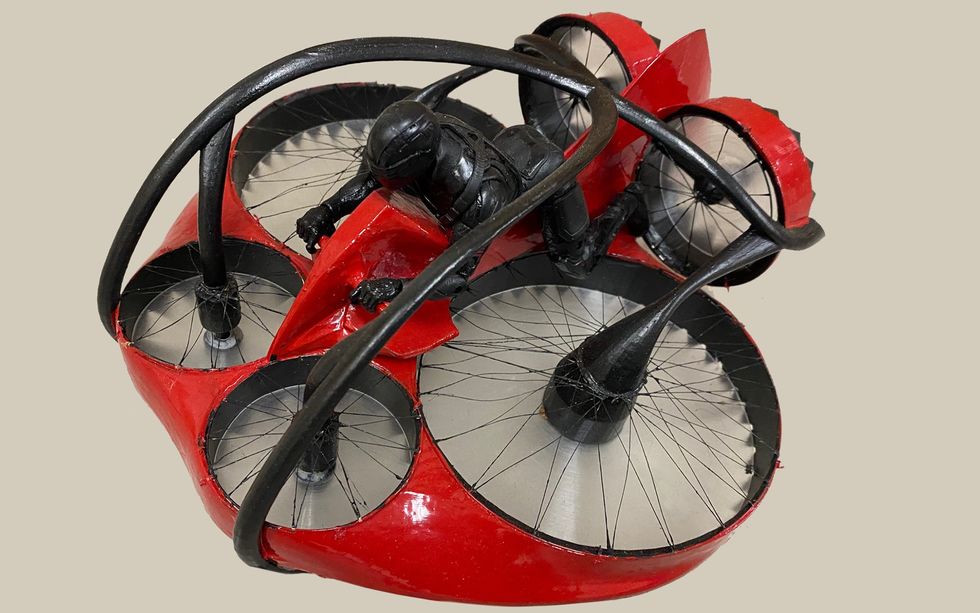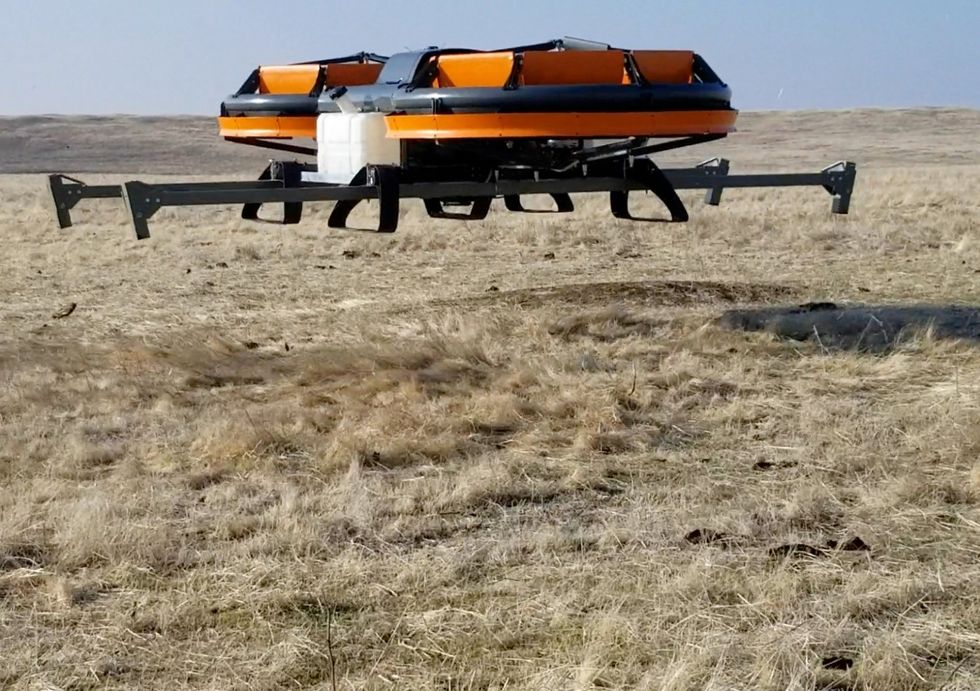Ever since Return of the Jedi premiered in 1983, people have been imagining the day when they, like the film’s protagonist Luke Skywalker, would get to ride speeder bikes that zip across the landscape while hovering just a few meters above the ground. In the intervening years, there have been numerous claims made by companies that they’ve figured out how to make a real-world product that mimics movie magic. Their demos and PR campaigns have continued to whet the public’s appetite for hoverbikes, but there are some solid reasons why the nascent hoverbike industry has yet to get airborne.
“it’s gonna happen, but I don’t know if it’ll happen in your lifetime and mine,” says Ronald Barrett-Gonzalez, an aerospace-engineering professor at the University of Kansas. “With the current approaches, I think it’s just going to be a while.”
Barrett-Gonzalez was the advisor for a group of University of Kansas aerospace-engineering grad students who participated in the GoFly competition, sponsored by Boeing. The challenge—in which 3,800 teams from 100 countries participated—was to “design and build a safe, quiet, ultra-compact, near-VTOL personal flying device capable of flying 20 miles [32 kilometers] while carrying a single person.”
The eventual grand prize winner was to have been awarded US $1 million, and $250,000 prizes were supposed to have gone to the quietest and the smallest compliant GoFly entries when the challenge concluded in September 2023. But the scheduled final fly-off between the teams whose personal aircraft were selected as the best-built entries in the second of the competition’s three phases was canceled because windy conditions made it unsafe for the machines to take to the skies.
Solving the Physics of Hoverbikes
“Helicopters, for a long time, have been built with relatively small engines for their size,” says Barrett-Gonzalez. “The way that such large vehicles can be lifted by small engines is that they have large rotor diameters. The volume of the column of air that they stand on is great. If you look at hoverbikes, the diameters of their rotors are much smaller. And physics says that you need more power per unit weight to lift an aircraft like that.”
To get the efficiency that comes along with a helicopter’s extensive rotor sweep, hoverbike designers will likely have to give up the thought of these machines touching down in parking spots meant for cars, or at least wait for new generations of engines and electric motors with greater power density to appear along with batteries capable of delivering a lot more power and storing a lot more energy than those available today.
Assessing Hoverbikes’ Risks
Safety concerns are just as big a hurdle to making hoverbikes available for sale. The University of Kansas team’s GoFly entry, called Mamba, had been one of 10 Phase I winners for best design. The six-rotored hexcopter, which emphasized safety, certifiability, and performance, featured shrouded rotors and a tilting stabilizer surface.
 The University of Kansas’ GoFly entry is a red-and-black hexcopter with two large and two small horizontal rotors, and two vertically placed rotors in the back. University of Kansas
The University of Kansas’ GoFly entry is a red-and-black hexcopter with two large and two small horizontal rotors, and two vertically placed rotors in the back. University of Kansas
But Mamba didn’t make it through Phase II, the build stage. Barrett-Gonzalez explains that “the kinds of safety criteria that we hold to are enforced by rules and regulations, such as the U.S. government’s FAR 23 airworthiness standards that govern small airplanes and FAR 27 standards for smaller helicopters.” That standard of safety, he says, is meant to ensure that the probability of a fatal event is no greater than one in 1 million flight hours. “For larger aircraft like the big Boeing commercial jets and larger helicopters, the standard is even more stringent. It’s one in 1 billion flight hours.”
That focus on safety doesn’t come without a cost, Barrett-Gonzalez adds. “The current thing that is keeping an aircraft like the Mamba from going from the drawing board to reality is that it’s costly. We could do what a Star Warspodracer can do, but that’s a $3.2 million machine. And then, only maybe Elon Musk and half a dozen other people could afford it.”
Several would-be hoverbike manufacturers have enticed potential buyers with price points more than an order of magnitude lower than Barrett-Gonzalez’s estimate. But Barrett-Gonzalez points out that they don’t include the combination of safety features built into the Mamba design. The Mamba has a roll cage, and the motors are cross-shafted. “So if you lose one motor you don’t come spiraling out of the sky,” he says. What’s more, the Mamba’s rotors are arranged according to a patented design that the team says makes it impossible for a rider or bystander to come in contact with the machine’s spinning blades.
For anyone who might argue that the Mamba project imploded because of overdesign, Barrett-Gonzalez recalls the Mamba team having extensive briefings with the director of the U.S. Federal Aviation Administration’s small airplanes directorate. “And he put it plainly: ‘The FAA will not certify a human eggbeater,’” says Barrett-Gonzalez.
“We could do what a Star Wars podracer can do, but that’s a $3.2 million machine. And then, only maybe Elon Musk and half a dozen other people could afford it.” —Ronald Barrett-Gonzalez, University of Kansas
Hover (a hoverbike hopeful formerly known as Hoversurf) recently moved its headquarters from California back to Russia, and Joby Aviation decided to start its electric vertical-takeoff-and-landing (eVTOL) air taxi business in Dubai. These moves might not necessarily indicate their need to generate revenue before refinements to their designs will give them the ability to meet U.S. safety standards. But that explanation is as plausible as any. “Neither Russia nor Dubai have mature airborne safety standards that cover vehicles of this type,” says Barrett-Gonzalez.
Where Are They Now?
In 2014, IEEE Spectrum reported on Aerofex’s pledge to deliver a commercially available hoverbike, the Aero-X, by 2017. Spoiler alert: It didn’t happen. Though Aerofex is still in business, the company retired the Aero-X before the aircraft’s anticipated go-to-market date. The company proudly recalls the progress it made during Aero-X’s development, including kinesthetic control, which lets the pilot stabilize and control a personal aircraft by shifting their weight pretty much the same way one does when riding a bike. But 16 years after its 2008 maiden flight, the $85,000 Aero-X is still not available for sale.
 Seven years after its initial go-to-market date, Aerofex’s Aero-X is still not available for sale.Aerofex
Seven years after its initial go-to-market date, Aerofex’s Aero-X is still not available for sale.Aerofex
Meanwhile, Hover’s series of Scorpion hoverbike designs have gotten plenty of press attention. But as of this writing, the company’s flying motorcycles are still in the preorder stage, with no indication regarding when models like the $150,000 S-3 will be delivered to people who put down deposits.
And Tetra Aviation, the Tokyo startup that won the $100,000 Pratt & Whitney Disruptor Award by the GoFly judges for its Mk-5 single-seat eVTOL vehicle, is also stuck in the development phase. Tetra said it planned to offer the Mk-5, with its 32 vertical lift rotors distributed across long, thin, aluminum-and-carbon-fiber wings and a single pusher prop at the rear, for $320,000, beginning in 2022. But the 8.5-meter wide, 6.1-meter-long machine, which is supposed to travel 160 kilometers (at speeds up to 160 kilometers per hour) on a single charge, is still in the preorder stage.
According to the statements made by the companies seeking to market hoverbikes, the vehicles have been two or three years away for more than a decade. The market predictions made by these companies are starting to sound a lot like an old saw about nuclear fusion, which claims fusion has been “just 20 years away” for nearly 50 years.
From Your Site Articles
Related Articles Around the Web

